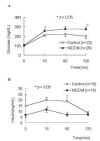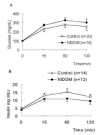The effect of cilostazol on glucose tolerance and insulin resistance in a rat model of non-insulin dependent diabetes mellitus
- PMID: 11590907
- PMCID: PMC4531709
- DOI: 10.3904/kjim.2001.16.2.87
The effect of cilostazol on glucose tolerance and insulin resistance in a rat model of non-insulin dependent diabetes mellitus
Abstract
Background: It has been reported that many peripheral vasodilating drugs might improve insulin resistance. Cilostazol, a antithrombotic agent, increases peripheral blood flow in non-insulin dependent diabetic patients. The effect of cilostazol treatment on insulin resistance in streptozotocin (STZ)-induced non-insulin dependent diabetic Wistar rats was examined.
Methods: About a half of two-day old neonate siblings were injected intraperitoneally with STZ and maintained for six months, at which time they were compared with age-matched control rats for intraperitoneal glucose tolerance test (IPGTT) and for glucose infusion rate (GINF) in a euglycemic hyperinsulinemic glucose-clamp study. After that, these studies were also performed after feeding rat chow containing cilostazol (100 mg/kg/day) to rats with STZ-induced non-insulin dependent diabetes mellitus for four-weeks and compared with those of age-matched control rats.
Results: In the intraperitoneal glucose tolerance test studies, plasma glucose levels of STZ-induced non-insulin dependent diabetic rats were significantly higher and plasma insulin levels significantly lower than those of age-matched control rats in the age of six months. Glucose infusion rate was lower in STZ-induced non-insulin dependent diabetic rats than those of age-matched control rats. However, after a four-week cilostazol treatment, glucose infusion rate of STZ-induced non-insulin dependent diabetic rats was not significantly different from that of control rats.
Conclusion: These findings suggested that cilostazol may improve insulin resistance in STZ-induced non-insulin dependent diabetic rats.
Figures




Similar articles
-
Cilostazol, a phosphodiesterase inhibitor, improves insulin sensitivity in the Otsuka Long-Evans Tokushima Fatty Rat, a model of spontaneous NIDDM.Diabetes Obes Metab. 1999 Jan;1(1):37-41. doi: 10.1046/j.1463-1326.1999.00002.x. Diabetes Obes Metab. 1999. PMID: 11221811
-
Effect of magnesium sulfate administration to improve insulin resistance in type 2 diabetes animal model: using the hyperinsulinemic-euglycemic clamp technique.Fundam Clin Pharmacol. 2018 Dec;32(6):603-616. doi: 10.1111/fcp.12387. Epub 2018 Jul 4. Fundam Clin Pharmacol. 2018. PMID: 29869808
-
Investigation of insulin resistance in the popularly used four rat models of type-2 diabetes.Biomed Pharmacother. 2018 May;101:155-161. doi: 10.1016/j.biopha.2018.02.084. Epub 2018 Feb 24. Biomed Pharmacother. 2018. PMID: 29486333
-
GABA dramatically improves glucose tolerance in streptozotocin-induced diabetic rats fed with high-fat diet.Eur J Pharmacol. 2018 May 5;826:75-84. doi: 10.1016/j.ejphar.2018.01.047. Epub 2018 Jan 31. Eur J Pharmacol. 2018. PMID: 29391158
-
Streptozotocin-Induced Diabetes Mellitus in Neonatal Rats: An Insight into its Applications to Induce Diabetic Complications.Curr Diabetes Rev. 2019;16(1):26-39. doi: 10.2174/1573399815666190411115829. Curr Diabetes Rev. 2019. PMID: 30973111 Review.
Cited by
-
Effects of a Phosphodiesterase inhibitor on the Browning of Adipose Tissue in Mice.Biomedicines. 2022 Aug 1;10(8):1852. doi: 10.3390/biomedicines10081852. Biomedicines. 2022. PMID: 36009398 Free PMC article.
-
Phosphodiesterase inhibitor improves renal tubulointerstitial hypoxia of the diabetic rat kidney.Korean J Intern Med. 2012 Jun;27(2):163-70. doi: 10.3904/kjim.2012.27.2.163. Epub 2012 May 31. Korean J Intern Med. 2012. PMID: 22707888 Free PMC article.
-
Role of Phosphodiesterase in the Biology and Pathology of Diabetes.Int J Mol Sci. 2020 Nov 3;21(21):8244. doi: 10.3390/ijms21218244. Int J Mol Sci. 2020. PMID: 33153226 Free PMC article. Review.
-
A Review of Antidiabetic Medicinal Plants as a Novel Source of Phosphodiesterase Inhibitors: Future Perspective of New Challenges Against Diabetes Mellitus.Med Chem. 2024;20(5):467-486. doi: 10.2174/0115734064255060231116192839. Med Chem. 2024. PMID: 38265379 Review.
-
Cilostazol attenuates the severity of peripheral arterial occlusive disease in patients with type 2 diabetes: the role of plasma soluble receptor for advanced glycation end-products.Endocrine. 2015 Aug;49(3):703-10. doi: 10.1007/s12020-015-0545-6. Epub 2015 Feb 11. Endocrine. 2015. PMID: 25666934 Free PMC article. Clinical Trial.
References
-
- Pollare T, Lithell H, Selinus I, Berne C. Application of prazocin is associated with an increase of insulin sensitivity in obese patients with hypertension. Diabetologia. 1988;31:415–420. - PubMed
-
- Jauch KW, Hartl W, Guenther B, Wicklmayr M, Rett K, Dietze G. Captopril enhances insulin responsiveness of forearm muscle tissue in non-insulin dependent diabetes mellitus. Eur J Clin Invest. 1987;17:448–454. - PubMed
-
- Nishi T, Tabusa F, Tanaka T, Shimizu T, Kanbe T, Kimura Y, Nakagawa K. Studies on 2-oxoquinolinone derivatives as blood platelet aggregation inhibitors. II.6-[3-(1-cyclohexyl-5-tetrazolyl)propoxyl]- 1,2-dihydro-2-oxoquinolinone and related compounds. Chem Pharmacol Bull. 1983;31:1151–1157. - PubMed
-
- Kamiya T, Sakaguchi S. Hemodynamic effects of the antithrombotic drug cilostazol in chronic arterial occlusion in extremities. Arzneim-Forsch/Drug Res. 1985;35:1201–1203. - PubMed
-
- Okuda Y, Kimura Y, Yamashita K. Cilostazol. Cardivasc Drug Rev. 1993;11:451–465.
Publication types
MeSH terms
Substances
LinkOut - more resources
Full Text Sources
Medical
